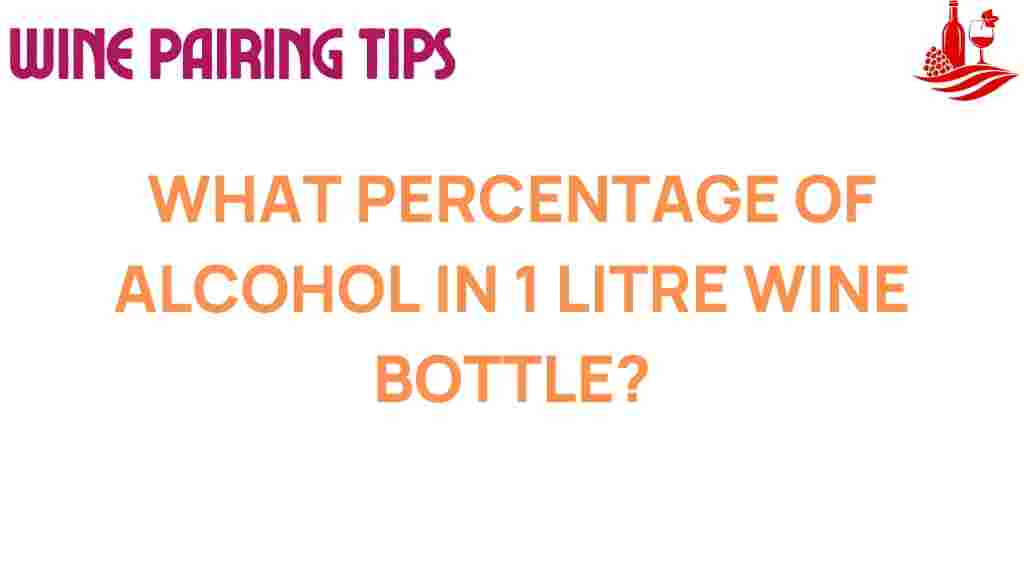Unveiling the Alcohol Content: What Percentage Lies in a Wine Bottle?
Understanding the alcohol content in a wine bottle is essential for both novice and seasoned wine enthusiasts. The percentage of alcohol in wine not only affects its flavor profile but also plays a crucial role in how it is enjoyed and paired with food. In this article, we will explore the various aspects of wine education, including how alcohol content is measured, factors that influence it, and some interesting wine facts that every wine lover should know.
What is Alcohol Content?
Alcohol content, often expressed as a percentage, indicates the volume of ethanol present in a beverage. In the case of wine, this percentage can vary widely depending on several factors, including the type of grapes used, fermentation processes, and regional regulations.
How is Alcohol Content Measured in Wine?
The alcohol content in a wine bottle is typically measured in terms of Alcohol by Volume (ABV). This measurement reflects the percentage of total volume that is pure alcohol. For example, a wine with an ABV of 12% contains 12% alcohol and 88% non-alcoholic components, primarily water and other compounds derived from the grapes.
Factors Affecting Alcohol Content in Wine Bottles
Several factors can influence the percentage of alcohol in a wine bottle:
- Grape Variety: Different grape varieties have varying sugar levels, which affects the fermentation process and ultimately the alcohol content.
- Climate: Warmer climates tend to produce grapes with higher sugar levels, resulting in wines with higher alcohol content.
- Winemaking Techniques: Techniques such as extended maceration and fermentation temperature can affect the final alcohol level.
- Region: Certain wine regions have regulations that dictate allowable alcohol levels, impacting the final product.
Common Alcohol Content Ranges for Different Wine Types
Understanding the typical alcohol content ranges for various types of wine can enhance your wine education. Here are some common categories:
- Light-bodied white wines: 8% – 12% ABV
- Full-bodied white wines: 13% – 15% ABV
- Light-bodied red wines: 11% – 13% ABV
- Full-bodied red wines: 13% – 15% ABV
- Dessert wines: 15% – 20% ABV
Step-by-Step Process: How to Determine Alcohol Content in Wine
If you’re curious about the alcohol content of a particular wine, follow these steps:
- Check the Label: The simplest way to find the alcohol content is to look at the wine bottle’s label. Most reputable wines will list the ABV percentage clearly.
- Consult Wine Databases: Online databases and apps can provide detailed information about specific wines, including their alcohol content.
- Ask a Wine Expert: Visiting a local wine shop or vineyard can provide insights from knowledgeable staff who can guide you in your quest for understanding wine.
Common Misconceptions about Alcohol Content
Many wine enthusiasts hold misconceptions about alcohol content. Here are a few to clarify:
- Higher Alcohol Equals Better Quality: Not necessarily. While some high-alcohol wines can be complex, quality is subjective and varies by personal preference.
- All Dessert Wines are High in Alcohol: Not all dessert wines are high in alcohol; some are made with lower alcohol levels to balance sweetness.
- Alcohol Content Doesn’t Affect Taste: Alcohol can significantly influence the mouthfeel and perceived sweetness of a wine.
Troubleshooting Tips for Wine Enthusiasts
If you’re struggling to understand or evaluate the alcohol content in wines, consider these troubleshooting tips:
- Take Notes: When tasting wines, jot down the ABV and your tasting notes. This will help you learn how different levels affect your experience.
- Try Blind Tasting: Conduct blind tastings to focus on flavors without bias towards alcohol content.
- Pair Wisely: Experiment with food pairings to see how the alcohol content interacts with various dishes.
Conclusion: Elevating Your Wine Knowledge
Understanding the alcohol content in a wine bottle is an integral part of wine education. By familiarizing yourself with the percentage of alcohol in different wines and recognizing the factors that influence it, you can enhance your appreciation for this timeless beverage. Remember, whether you are a casual drinker or a dedicated wine enthusiast, knowledge is power in the wine industry. For more information on wine and its complexities, visit Wine Enthusiast.
As you continue your journey into the world of wine, keep in mind that the more you learn, the more enjoyable your experiences will be. Cheers to the exploration and understanding of wine!
This article is in the category Tips and created by Wine Pairing Tips Team
